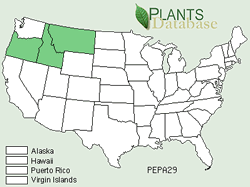Plant of the Week
 Range map of the Payette Beardtongue. States are colored green where the columbine may be found.
Range map of the Payette Beardtongue. States are colored green where the columbine may be found.
 Payette Beardtongue, Penstemon payettensis. Photo by Joe Duft.
Payette Beardtongue, Penstemon payettensis. Photo by Joe Duft.
Payette Beardtongue (Penstemon payettensis)
By Wayne Owen
Payette Beardtongue is a robust, commonly multi-stemmed herbaceous perennial that typically grows to approximately two feet tall. The foliage of this plant is usually clustered at the base of the plant, with increasingly smaller leaves toward the top of the flower stems. The leaves of Payette Beardtongue can be up to six inches long, are most often more or less elliptical in shape and hairless. Payette Beardtongue produces fantastic clusters of bright blue snapdragon-like flowers that are about an inch long. This plant usually blooms in mid-summer. You can find Payette Beardtongue in a small portion of eastern Oregon, a narrow band across central Idaho, and a limited area in southwest Montana. This plant is often found on talus or other open slopes from foothills to subalpine elevations. Payette Beardtongue is similar to several other beardtongue species:
- Penstemon procerus and Penstemon nitidus have smaller flowers,
- Penstemon cyaneus flowers tend to grow along one side of the flower stem rather than forming a complete whorl of flowers, and
- Penstemon lemhiensis is a rare plant that is restricted to a small area of eastern Idaho and adjacent Montana and has narrower leaves.
Payette Beardtongue was first collected on the Payette National Forest of central Idaho where it is a relatively common plant. Like many penstemons, Payette beardtongue is prized among rock garden enthusiasts; however, this plant does not transplant well and is best grown from seed. This plant does not tolerate compacted soils, and are easily damaged by foot and off-road vehicle traffic.
Penstemons are native to North America. The 270 plus species occurs in diversity of habitats, from deserts to wetlands and from the deep south to the high peaks of the Rocky Mountains. Penstemons have been extensively hybridized and are popular garden plants.

